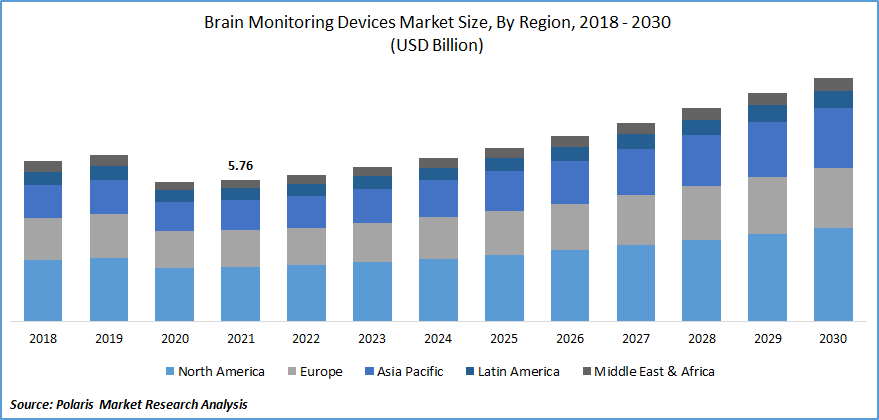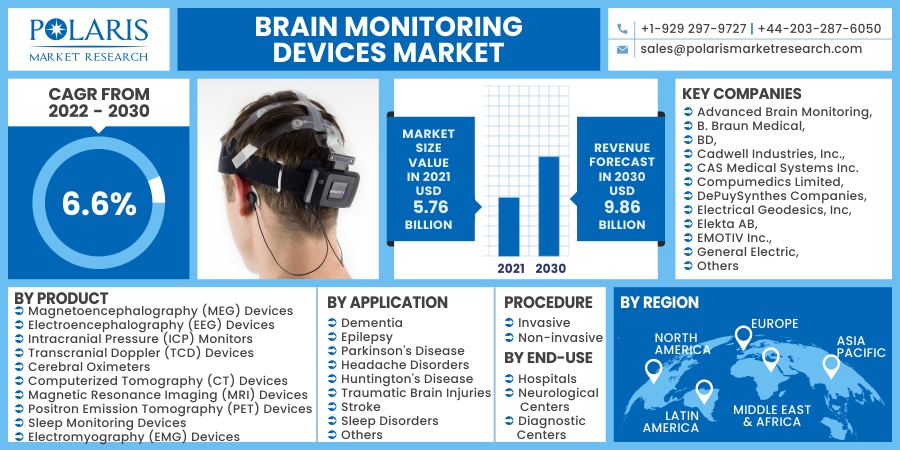
Brain Monitoring Devices Market Share, Size, Trends, Industry Analysis Report, By Product, By Procedure (Invasive, Non-invasive), By Application, By End-Use (Hospitals, Neurological Centers, Diagnostic Centers), By Region; Segment Forecast, 2022 - 2030
- Published Date:Mar-2022
- Pages: 118
- Format: PDF
- Report ID: PM2350
- Base Year: 2021
- Historical Data: 2018 - 2020
Report Outlook
The global brain monitoring devices market was valued at USD 5.76 billion in 2021 and is expected to grow at a CAGR of 6.6% during the forecast period. Increasing incidences of neurological disorders coupled with advancements in technology are expected to propel the brain monitoring devices market demand for the product over the projected period.
 Know more about this report: request for sample pages
Know more about this report: request for sample pages
Brain monitoring technologies are utilized to detect and diagnose anomalous processes that happen within the head. This equipment is effective in measuring cerebral activity as well as blood circulation inside the brain's blood vessels.
The present degree of research in the domain of portable and microsensor technologies for monitoring equipment is due to the growing downsizing and availability of detectors and circuits. This makes it easier to create methods for measuring complicated healthcare consequences in no specialist as well as distant locations.
Industry Dynamics
Growth Drivers
Some of the primary reasons boosting the global industry throughout the projected period is an increase in the incidence of neurological illnesses with an increase in the elderly demographic. A surge in head damage instances throughout the world is also fueling the development of the worldwide industry. Increased intracranial hypertension is a major source of subsequent brain damage, and ICP measurement has become an essential element of head imaging following brain trauma.
Increasing case of dementia globally is expected to boost the monitoring equipment industry demand. For instance, As per WHO figures, approximately 50 million individuals worldwide have developed dementia since September 2019, including over 10 million additional cases documented every year. It is amongst the leading sources of impairment and reliance between the world's elderly.
Furthermore, the occurrence of other illnesses and ailments, including sickle cell illness and heart abnormalities, is rising. Cardiac operations can occasionally interfere with regular mind activity, an additional important cause expected to fuel the head monitoring product industry demand over the projected period.

Know more about this report: request for sample pages
Report Segmentation
The market is primarily segmented based on product, procedure, application, end use, and region.
|
By Product |
By Procedure |
By Application |
By End Use |
By Region |
|
|
|
|
|
Know more about this report: request for sample pages
Insight by Product
Electroencephalography (EEG) equipment segment is expected to dominate the global monitoring equipment market because of a growth in the geriatric demographic and a growth in the use of EEG technology in operation facilities. Moreover, the rising frequency of neurological illnesses, including Alzheimer’s and epilepsy, will likely drive segment growth. Furthermore, increasing technological advancement in developed nations is expected to favor the trend.
Insights by Application
Traumatic brain injuries application segment is expected to grow at a considerable pace over the forecast period due to increasing TBI due to rising military compacts and accidents. Furthermore, increasing approvals of the latest devices in developed countries coupled with growing clinical trials for adopting new techniques are expected to fuel the segment growth.
Insight by End-Use
Hospital end-use segment is expected to hold the major share in the global market during the forecast period. These procedures are complex and expensive, requiring advanced technology products, and this equipment’s generally found in a hospital. Furthermore, the increasing growth of hospitals across several nations is expected to propel the market demand during the forecast period.
Neurological centers segment is expected to grow at a considerable rate during the anticipated period due to increasing trials of the latest and innovative monitoring equipment along with the presence of specialist doctors who provide proper guidance to the patients.
Geographic Overview
North America dominated the brain monitoring devices market in 2021 and is expected to maintain its dominance over the projected period due to the increasing prevalence of neurological diseases along with the increasing clinical trials for these products in countries including the U.S. and Canada.
Asia Pacific market is expected to grow at a considerable pace during the forecast period due to the increasing population of geriatric people in countries such as Japan and China. Increasing geriatric population is expected to increase the market demand.
Competitive Insight
Some of the key market players operating in the global brain monitoring devices market include Advanced Brain Monitoring, B. Braun Medical, BD, Cadwell Industries, Inc., CAS Medical Systems Inc. Compumedics Limited, DePuy Synthes Companies, Electrical Geodesics, Inc, Elekta AB, EMOTIV Inc., General Electric, Integra LifeSciences Corporation, Koninklijke Philips N., Masimo Corporation, Medtronic, Natus Medical Incorporated, NIHON KOHDEN CORPORATION, Rimed Inc., Siemens Healthcare Private Limited, and Yokogawa Electric Corporation.
These companies are investing in research & development and are adopting marketing strategies such as partnerships and collaboration, mergers & acquisitions, innovative product launches, and others to compete in the market and increase their customer base. For instance, Masimo gained CE Mark certification in March 2019 for their next-generation SedLine brain activity monitoring for pediatric children aged one to 18 years old; the devices analyze brain activity while a person is sedated.
Brain Monitoring Devices Market Report Scope
|
Report Attributes |
Details |
|
Market size value in 2021 |
USD 5.76 billion |
|
Revenue forecast in 2030 |
USD 9.86 billion |
|
CAGR |
6.6% from 2022 - 2030 |
|
Base year |
2021 |
|
Historical data |
2018 - 2020 |
|
Forecast period |
2022 - 2030 |
|
Quantitative units |
Revenue in USD billion and CAGR from 2022 to 2030 |
|
Segments covered |
By Product, By Procedure, By Application, By End Use, By Region |
|
Regional scope |
North America, Europe, Asia Pacific, Latin America, Middle East & Africa |
|
Key Companies |
Advanced Brain Monitoring, B. Braun Medical, BD, Cadwell Industries, Inc., CAS Medical Systems Inc. Compumedics Limited, DePuySynthes Companies, Electrical Geodesics, Inc, Elekta AB, EMOTIV Inc., General Electric, Integra LifeSciences Corporation, Koninklijke Philips N., Masimo Corporation, Medtronic, Natus Medical Incorporated, NIHON KOHDEN CORPORATION, Rimed Inc., Siemens Healthcare Private Limited, and Yokogawa Electric Corporation. |
